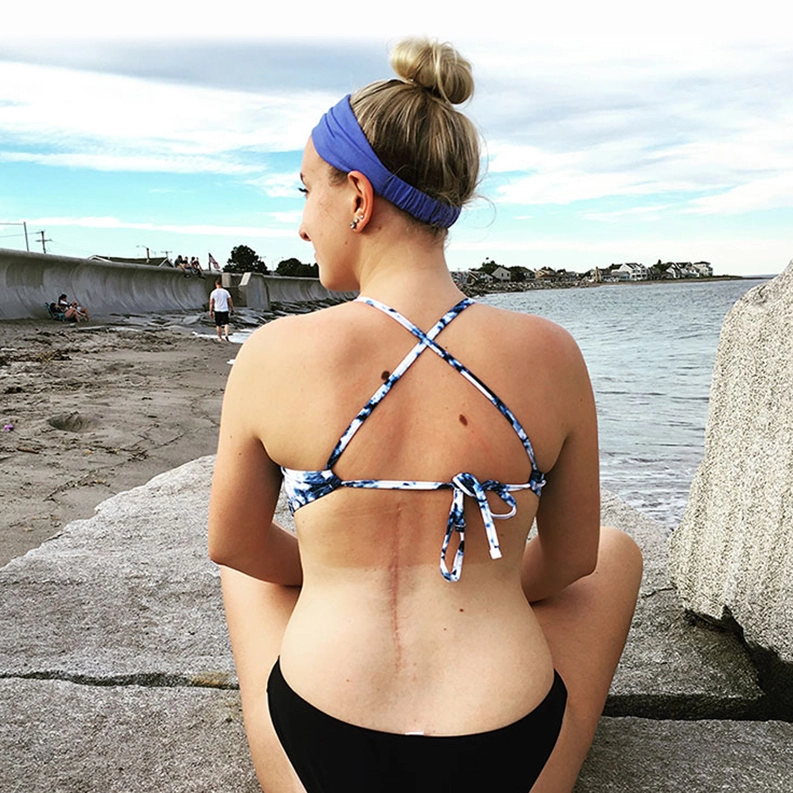"I’m not letting you leave my office with that on your back."
Jordan remembers her dermatologist’s words at the appointment that changed her life. At just 20 years old, she was diagnosed with advanced, stage III melanoma.
"Why me? I was too young to get skin cancer," she remembers thinking. "I felt that I had done everything I could to limit my risk of skin cancer."
But Jordan soon learned that while skin protection is important, skin cancer and melanoma can't always be prevented.
Melanoma is the most serious and life-threatening type of skin cancer, but it is almost always treatable when caught early.1 Many times, melanoma is caused by damage to the DNA in skin cells.1 This damage to the DNA (often called a gene mutation) can cause cancerous tumors to form in the skin.2
Jordan was a junior in college when a friend accidentally scratched a mole on her back, causing searing pain and a feeling that something was wrong. Several dermatologist and oncologist appointments later, Jordan learned she had stage III melanoma that had spread to her lymph nodes.
Her oncologist quickly recommended surgery. Eighteen lymph nodes were removed from her underarms, and she was left with a 14-inch (35.56 cm) scar up the center of her back.

Surgery to remove the cancerous cells is usually the first treatment for stage III melanoma.3 After surgery, patients may receive additional treatments to help lower the risk of the cancer returning, such as targeted therapies.3
As a nursing student, Jordan understood the seriousness of the cancer having spread to her lymph nodes.
"I went back to school after the holidays feeling angry and anxious," she remembers.
Jordan’s ray of hope and path to treatment
Shortly after her diagnosis, Jordan’s oncologist told her about something called a BRAF mutation, and how knowing her BRAF status could help inform her treatment plan.
"I knew within 2 months of my diagnosis what the plan was to treat my cancer," Jordan recalled.
About half of all cases of melanoma have a BRAF mutation.4 This means there are changes in a specific gene—the BRAF gene—that has caused cancer cells to form and grow4. Using a small piece of the tumor, a gene test can detect BRAF mutations.5
As someone who had a BRAF mutation test conducted right away, I know firsthand how empowering that information can be, and I encourage other patients to have conversations about their BRAF mutation status early in their diagnosis. Knowing my BRAF status allowed me to make a fully informed decision.
During the course of her treatment, Jordan had support from her family, her friends and her now-husband, but she recalls how challenging and scary it was to be diagnosed with cancer, especially at such a young age.
"It was really difficult—and I was trying to be strong," she said. "During treatment my oncologist even said to me, ‘You don’t get a gold star for doing this on your own.’"
Jordan explains that learning she was BRAF-positive changed how she thought about her diagnosis. She called it an emotional turning point for her and her loved ones and remembers celebrating with her friends the night she received the news from her oncologist.
"The day I learned I was BRAF positive, I felt it was the light I was looking for. I felt so empowered."
Jordan’s message today
An extreme optimist, Jordan feels her experiences have made her stronger and she is grateful for the opportunity to share her story.
Today, Jordan is in remission. She graduated from nursing school and works as a critical care nurse, where she has been on the front-line of the COVID-19 pandemic. With her own health scare as background, she feels grateful to be able to meaningfully help others through her work.

"It is clear to me that COVID-19 may have implications that won’t come to light for some time—just think about how many cases of melanoma may have gone undiagnosed in 2020," Jordan said, reflecting on her own perspective as a melanoma survivor.
It is more important than ever for people to get back to their regular doctor visits, including skin checks specifically.
According to the World Health Organization, there were more than 324 000 new cases of melanoma and more than 57 000 melanoma-related deaths worldwide in 2020.6 The Global Coalition for Melanoma Patient Advocacy recently surveyed more than 700 dermatologists who estimate that approximately one-fifth of melanomas (21%) may have gone undiagnosed in 2020, with one-third of appointments (33.6%) missed due to the COVID-19 pandemic.7 An analysis of 20 health care institutions representing more than 28 million people showed an estimated 67% decrease in the incidence of new melanoma cases in April 2020 compared with April 2019.8
Jordan’s experience with melanoma has led her to encourage others to advocate for their health, urging regular skin cancer screenings and, for other patients with melanoma, to understand their mutation status and their options.
"It’s more important than ever for people to get back to their regular doctor visits, including skin checks," she said. "Be an advocate for yourself. Talk to your doctor and know your status!"



